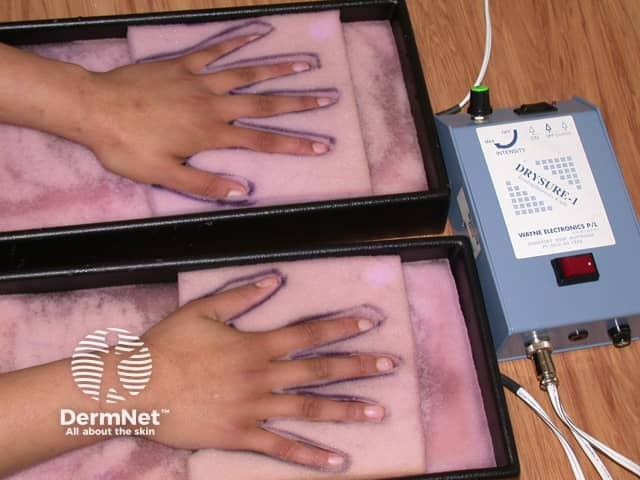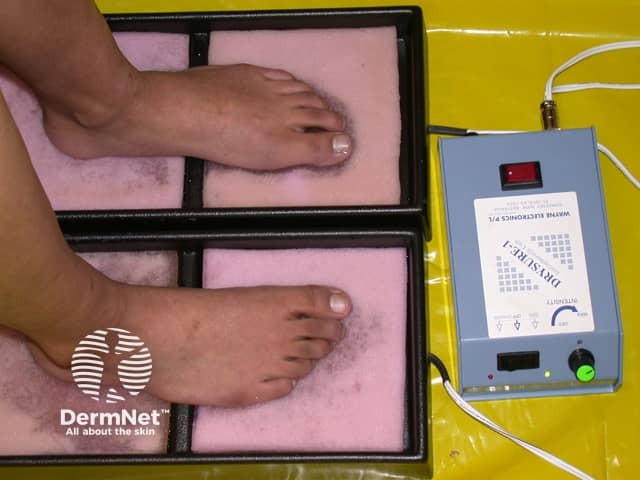Main menu
Common skin conditions

NEWS
Join DermNet PRO
Read more
Quick links
Iontophoresis — extra information
Iontophoresis
Author: Alana Cole, 5th Year Medical Student, University of Auckland. Chief Editor: Dr Amanda Oakley, Dermatologist, Hamilton, New Zealand, April 2015.
Introduction Uses How it works What to expect Side effects and risks Contraindications
What is iontophoresis?
Iontophoresis is a procedure in which an electrical current is passed through skin soaked in tap water (not distilled water), normal saline (0.9%), or a solution containing an anticholinergic medication, which allows ionised (charged) particles to cross the normal skin barrier. It reduces sweating and enhances the delivery of drugs and macromolecules into and through the skin. It is safe, effective and inexpensive.

Iontophoresis for palmar hyperhidrosis

Iontophoresis for plantar hyperhidrosis
What is iontophoresis used for?
The main use of iontophoresis is to treat focal areas of excessive sweating (hyperhidrosis), particularly on the palms or soles. Tap-water iontophoresis is less effective in the axilla.
Limited robust data is available; some studies suggested that up to 80–85% of patients with palmar hyperhidrosis notice a subjective improvement in their symptoms within 2–4 weeks. One study of tap-water iontophoresis showed 33% improvement on the soles and 37.5% in the axillae after 14 days, which increased to 78%, and 75% respectively over 20 days.
Iontophoresis has also been successfully used to deliver drugs to the skin in order to:
- Reduce sweating further using an anticholinergic agent such as glycopyrronium or botulinum toxin A.
- Anaesthetise an area of skin with lignocaine.
- Treat fungal infection of the nail plate (onychomycosis).
- Eradicate infection due to resistant micro-organisms using silver ions
- Treat bursitis or tendonitis with anti-inflammatory drugs.
How does iontophoresis work in hyperhidrosis?
The mechanism of action of iontophoresis in reducing sweating is not completely understood. Sweat forms in response to an electrical gradient produced by sympathetic nerve activity on the cells of the sweat gland. There are several theories as to how a change in the electrical gradient reduces sweat production.
- Ions produced by iontophoresis may physically block the sweat ducts in the stratum corneum.
- The external electrical current may disrupt normal sympathetic nerve transmission.
- The pH drops in the sweat gland due to an accumulation of hydrogen ions.
Iontophoresis for hyperhidrosis is usually carried out with ordinary tap water, however, sodium chloride electrolyte solution or an anticholinergic agent such as glycopyrronium bromide) can be added if the water alone is not effective.
Procedure/what to expect
Battery-powered Direct Current (DC) and mains-powered Alternating Current (AC) devices are available. Individual machines vary, and the instructions provided by the manufacturer should be followed carefully.
For palmar hyperhidrosis, each hand is placed in a tray of water that contains active and indifferent electrodes. It is recommended that petroleum jelly is applied to the skin at the water-line, and to any small cuts or wounds to prevent discomfort and localised inflammation. The device is switched on so that current passes through the water between the electrodes. The initial current should be very low and then adjusted according to tolerance.
Initially, treatment is undertaken for 20–30 minutes every 1–3 days until the desired effect is achieved, and then reduced to once per week to maintain the result. It is up to the patient to find what treatment regime works best to maintain results.
Side effects and risks of iontophoresis
Iontophoresis is generally a safe procedure. It is important to avoid direct contact with the electrodes during treatment, as it may cause a mild electric shock.
A feeling of pins and needles or burning sensation is experienced by most people. Adverse effects may include:
- Redness of treated skin
- Small blisters(vesicles) or pompholyx
- Dry and cracked skin or dermatitis.
Although these side effects from iontophoresis are expected to resolve within a few days, emollients/moisturisers should be applied several times daily to reduce symptoms. Topical corticosteroids can be applied.
If used, anticholinergic drugs such as glycopyrronium may be absorbed into the body and produce systemic side effects such as dizziness, dry eyes and dry mouth.
Contraindications to iontophoresis
Iontophoresis should not be used by:
- A patient who is epileptic or has a history of seizures
- A patient with a heart condition or a pacemaker
- A patient with a metal implant
- A pregnant woman.
Patients should delay treatment if they have a recent wound, skin graft, or scar in the area requiring treatment, as iontophoresis may be painful and the treatment less effective.
References
- Arndt KA, Hsu JTS. Manual of Dermatologic Therapeutics, 7th edition. Lippincott Williams & Wilkins, Philadelphia (2007).
- Pariser DM, Ballard A. Iontophoresis for palmar and plantar hyperhidrosis. Dermatol Clin. 2014 Oct;32(4):491–4. doi: 10.1016/j.det.2014.06.009. Epub 2014 Jul 24. PubMed PMID: 25152342.
- Rose JB, Galinkin JL, Jantzen EC, Chiavacci RM. A study of lidocaine iontophoresis for pediatric venipuncture. Anesth Analg. 2002 Apr;94(4):867–71, table of contents. PubMed PMID: 11916787.
On DermNet
Other websites
- Iontophoresis — Hyperhidrosis UK
